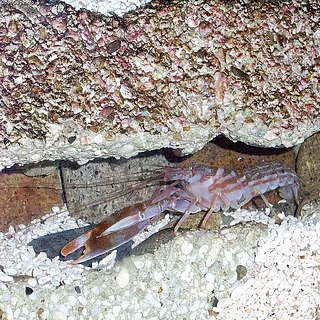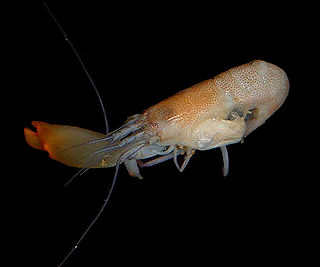
The Caridea, commonly known as caridean shrimp or true shrimp, are an infraorder of shrimp within the order Decapoda. This infraorder contains all species of true shrimp. They are found widely around the world in both fresh and salt water. Many other animals with similar names – such as the mud shrimp of Axiidea and the boxer shrimp of Stenopodidea – are not true shrimp, but many have evolved features similar to true shrimp.

The tiger pistol shrimp belongs to the family of snapping shrimp.
Physetocaris is a monotypic genus of caridean shrimp, containing a single species, Physetocaris microphthalma.

Alpheidae is a family of caridean snapping shrimp, characterized by having asymmetrical claws, the larger of which is typically capable of producing a loud snapping sound. Other common names for animals in the group are pistol shrimp or alpheid shrimp.

Alpheopsis is a genus of shrimp of the family Alpheidae. Several species of the genus have been known to share the same burrows with members of different species. They are inhabitants of the eastern Pacific Ocean.

Synalpheus is a genus of snapping shrimp of the family Alpheidae, presently containing more than 160 species; new ones are described on a regular basis, and the exact number even of described species is disputed.

Alpheus novaezealandiae is a species of shrimp in the family Alpheidae, found in Australasia.

Alpheus rapacida, is a species of snapping shrimp of the family Alpheidae. It is found at depths of up to 56 metres (184 ft) across the Indo-West Pacific, with a few recent observations from the Mediterranean coasts of Israel and Turkey as a Lessepsian migrant.
Parhippolyte sterreri is a species of marine decapod crustacean in the family Barbouriidae, formerly placed in the genus Somersiella. It is found in marine caves around the Bahamas, Cuba and Mexico and inland anchialine caves in Bermuda.

Alpheus randalli is a species of snapping shrimp in the family Alpheidae. It lives in the Marquesas Islands and parts of the Indian Ocean, including the Seychelles, in association with a goby of the genus Amblyeleotris. The shrimp is transparent or white with prominent red markings.

Lysmata is a genus of shrimp in the infraorder Caridea, the caridean shrimp. The genus belongs to the family Lysmatidae. Lysmata are popular ornamental shrimp in the marine aquarium trade for their bright color patterns, interesting behaviors, and ability to control certain aquarium pests such as sea anemones of the genus Aiptasia. They are known to command high prices on the pet market.

Neotrypaea californiensis, the Bay ghost shrimp, is a species of ghost shrimp that lives on the Pacific coast of North America. It is a pale animal which grows to a length of 11.5 cm (4.5 in). One claw is bigger than the other, especially in males, and the enlarged claw is thought to have a function in mating. N. californiensis is a deposit feeder that lives in extensive burrow systems, and is responsible for high rates of bioturbation. It adversely affects oyster farms, and its numbers are controlled in some places by the application of pesticides. It carries out an important role in the ecosystem, and is used by fishermen as bait.

Alpheus heterochaelis, the bigclaw snapping shrimp, is a snapper or pistol shrimp in the family Alpheidae. It is found in the western Atlantic Ocean and the Gulf of Mexico.
Alpheus tricolor is a crustacean belonging to the family of snapping shrimp. It was first isolated in Indonesia and Sri Lanka. It counts with a setose carapace, an acute rostrum, shallow adrostral furrows and a basicerite with a strong ventrolateral tooth. The lamella of its scaphocerite is not reduced, with an anterior margin that is concave. Its third maxilliped counts with an epipodial plate bearing thick setae, while its first chelipeds are found with their merus bearing a strong disto-mesial tooth; its third pereiopod has an armed ischium, with a simple and conical dactylus. Its telson is broad, distally tapering, with 2 pairs of dorsal spines. The species is named after its characteristic colour pattern, including white, red and orange.

Alpheus fasqueli is a crustacean belonging to the family of snapping shrimp. It was first isolated in Sri Lanka. It counts with a setose carapace, an acute and carinate rostrum, and unarmed orbital hoods. Its basicerite has a strong ventrolateral tooth. The lamella of its scaphocerite is not reduced. Its third maxilliped counts with an epipodial plate bearing thick setae, while its first chelipeds are found with their merus bearing a strong disto-mesial tooth; its third pereiopod has an armed ischium, with a simple and conical dactylus. Its telson is broad, distally tapering, with 2 pairs of dorsal spines. The species is named after Frédéric Fasquel, a photographer who contributed rare shrimp specimens for the Muséum national d'histoire naturelle.

Synalpheus pinkfloydi, the Pink Floyd pistol shrimp, is a species of snapping shrimp in the genus Synalpheus. Described in 2017, it was named after the rock band Pink Floyd, in part because it has a distinctive "bright pink-red claw". The sound it makes by snapping the claw shut reaches 210 decibels, and can kill nearby small fish.

Alpheus digitalis is a species of pistol shrimp in the family Alpheidae. The species was first discovered after a taxonomic study of a snapping shrimp from the genus Alpheus from Japan and the Gulf of Thailand, of which, it was found that two species was confounded under A.digitalis, which was originally described based on a single specimen possessing abnormal chelipeds.

Alpheus armatus is a species of snapping shrimp in the family Alpheidae, found in shallow water in the Caribbean Sea and the Gulf of Mexico. It lives in association with a sea anemone such as Bartholomea annulata, clearing out sand from the cracks and crevices in which the sea anemone often lives.
Athanas sydneyensis is a species of small alpheid shrimp.

Alpheus macrocheles, also known as the orange European snapping prawn, is a species of snapping shrimp within the family Alpheidae.















